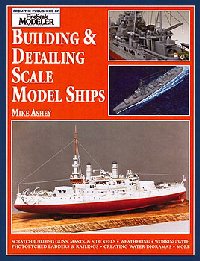|
|
| Tell me when this page is updated |
|
|
| Tell me when this page is updated |
|
|
Building and Detailing Scale Model Ships
by Mike Ashey, Kalmbach Books, Waukesha, Wisconsin, USA, 1996 Review by Felix Bustelo
 First off, the book covers the basics - sanding and gluing parts, filling gaps and seams, masking and painting. It offers an introduction to the tools used and the differences in variety of glues and fillers available on the market. The author discusses work organization and the differences between the more common injection molded kits and the limited production multimedia kits (resin and white metal). In fact, almost every chapter dedicates some space on tips and techniques that are specific to resin and white metal. The book covers in great detail working with photo-etching. Here is the book's strength in my opinion, as it discusses all aspects of dealing with photo-etched parts. The author carefully explains how to work with brass and stainless steel media. Cutting, shaping and bending p-e rails, ladders, stairs, cranes and radars is throughly explained as well as gluing and painting these details. The book's impressive array of photos really help the reader understand how to work with p-e; it sure helped me! The book also covers in depth rigging your ship model, again in pretty much plain English. There is a chapter dedicated to scratch-building components such as guns, decks, railings, rudders propeller shafts and v-struts. So, if you wish to replace some of the parts in your kit that do not meet your standards, this chapter is for you. Again, simple to follow text and excellent illustrations bring the points across. Well, once your model is completed, you have to show it off, so there is a chapter of how to display your model. Here, the author covers how to mount your model on pedestels, wood blocks and even how to improve the display stands that normally come with the model. This chapter also covers how to make a waterline diorama with a sea made from acrylic gel. I just wish that the chapter included steps on how to make simple plexiglass cases for the model . While the focus is on warships, a lot of the techinques can be used on merchant ships and liners. I found it to be an indespensible reference guide and it will always be within arm's reach of my work bench.
Return to Book Reviews |